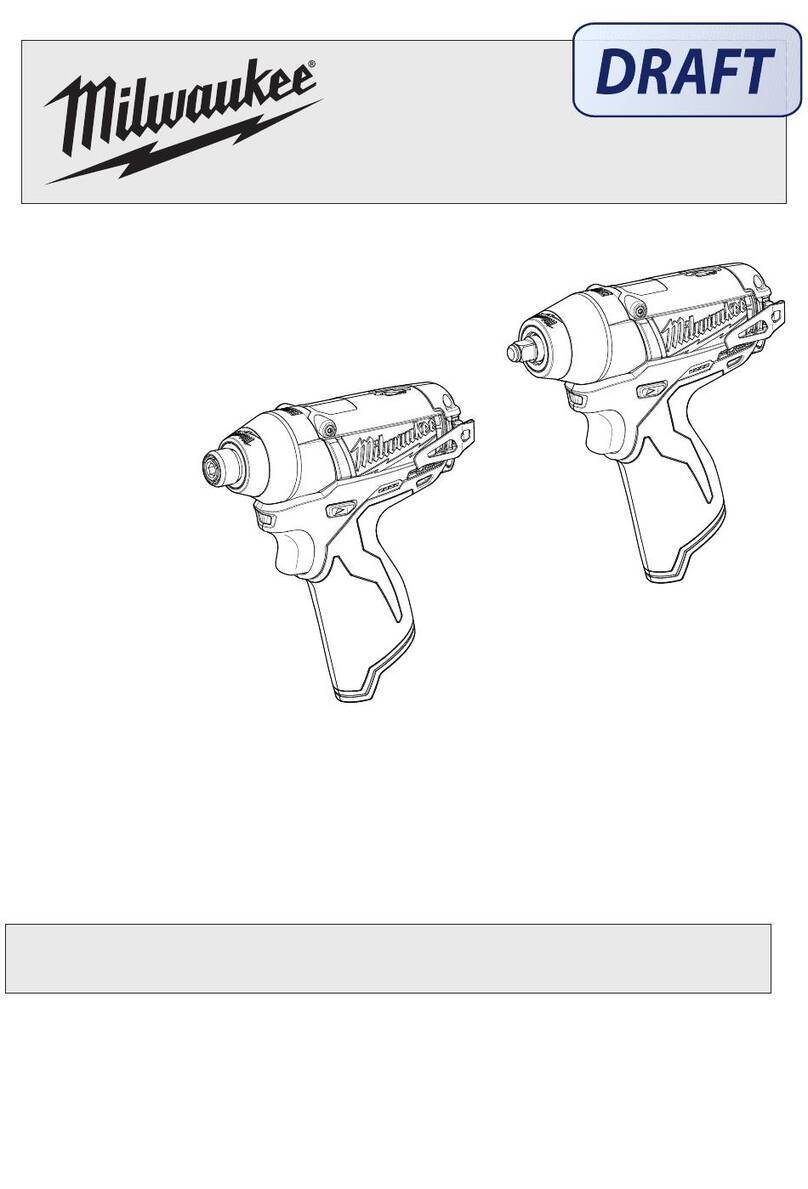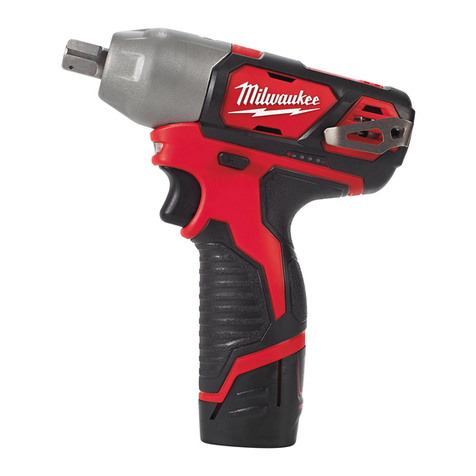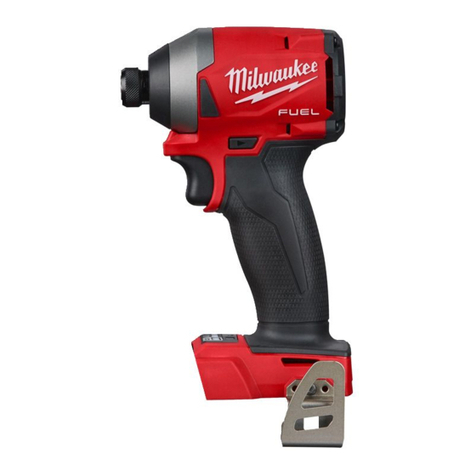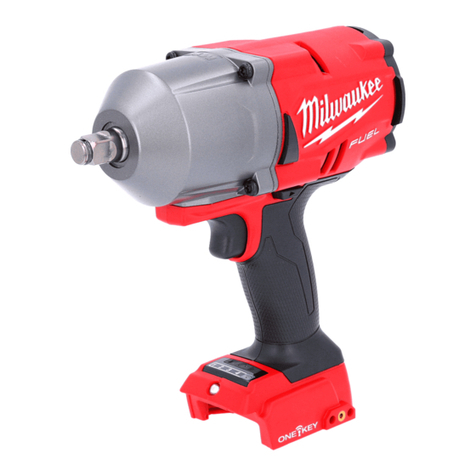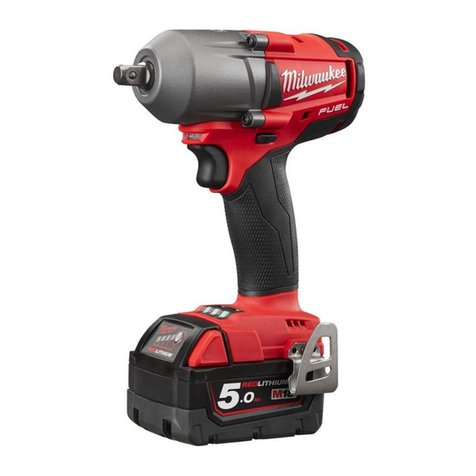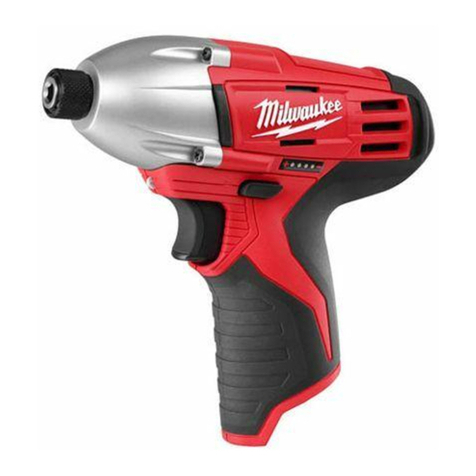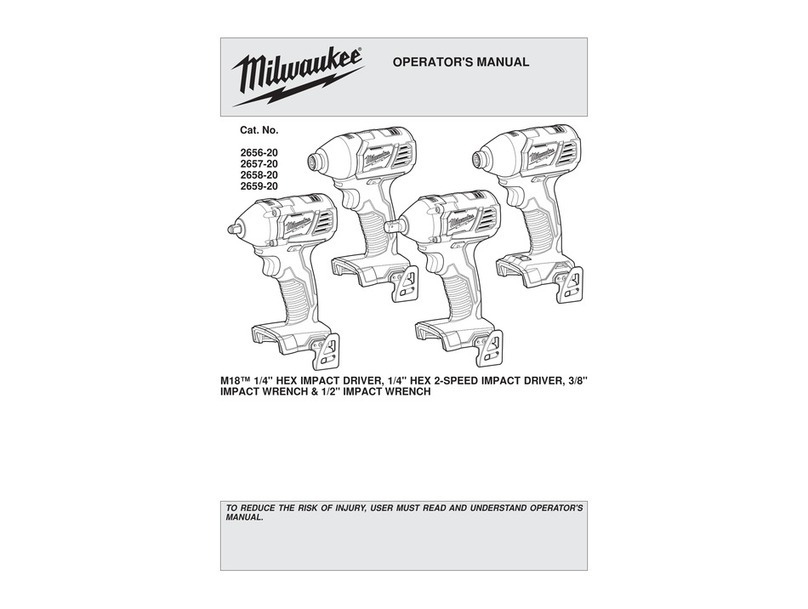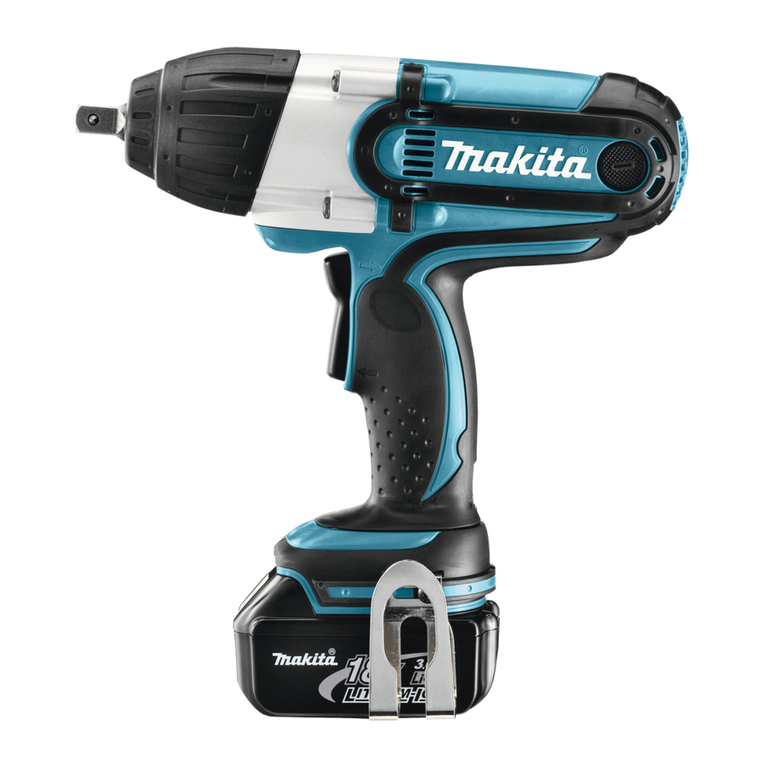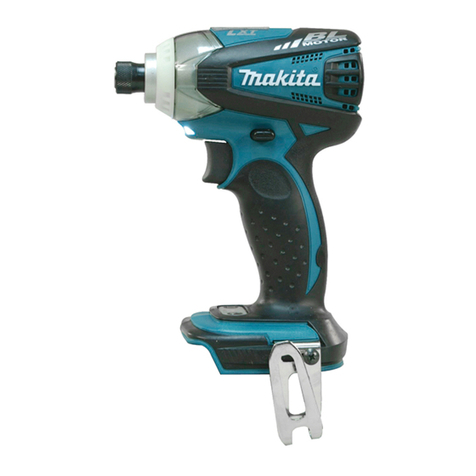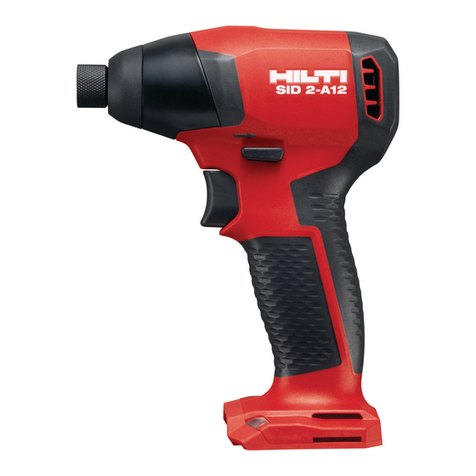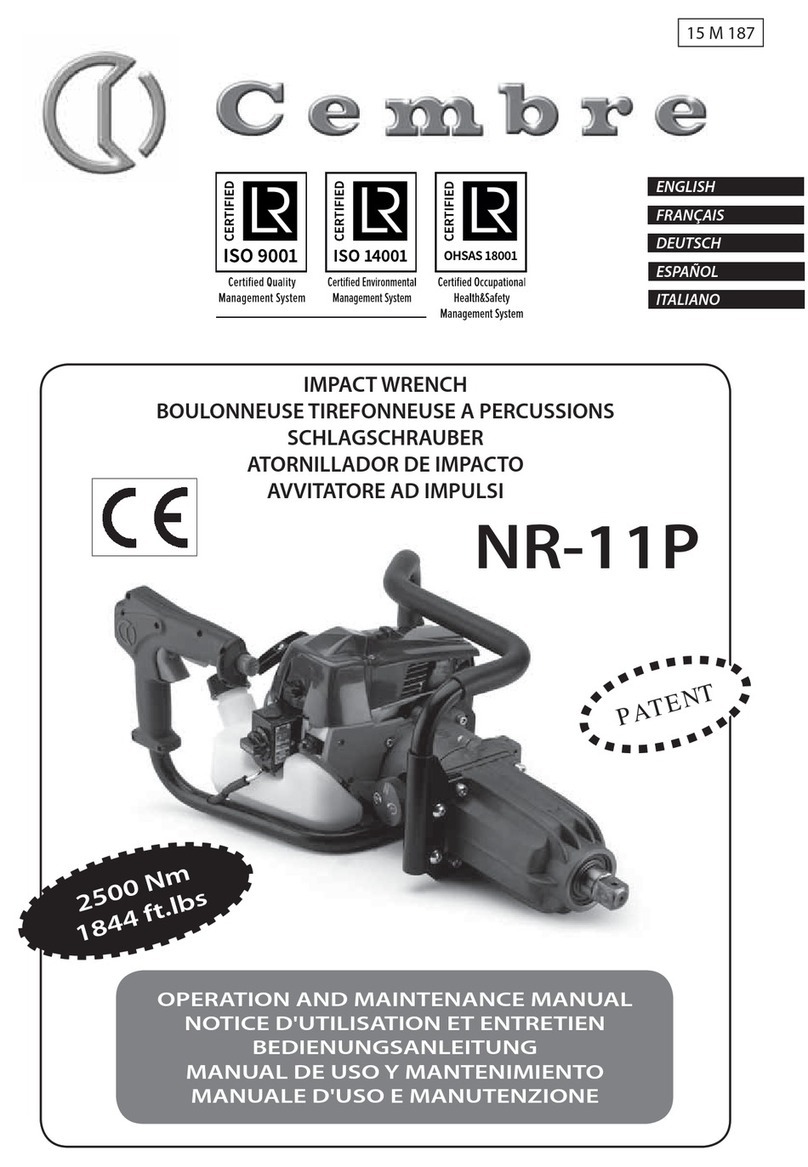2 3
1. Hold power tools by insulated grip-
ping surfaces when performing an
operation where the cutting tool may
contact hidden wiring orits own cord.
Contact with a “live” wire will make ex-
posed metal parts of the tool “live” and
shock the operator.
2. Maintainlabelsand nameplates. These
carry important information. If unread-
able or missing, contact a MILWAUKEE
service facility for a free replacement.
3. WARNING!Somedustcreatedbypower
sanding, sawing, grinding, drilling, and
other construction activities contains
chemicals known to cause cancer, birth
defectsorotherreproductive harm. Some
examples of these chemicals are:
• lead from lead-based paint
• crystallinesilica from bricksand cement
and other masonry products, and
• arsenic and chromium from chemically-
treated lumber.
Your risk from these exposures varies,
depending on how often you do this
type of work. To reduce your exposure
to these chemicals: work in a well ven-
tilated area, and work with approved
safety equipment, such as those dust
masks that are specially designed to
filter out microscopic particles.
WORK AREA SAFETY
ELECTRICAL SAFETY
PERSONAL SAFETY
WARNING
READ ALL INSTRUCTIONS
Failureto follow allinstructionslisted below mayresultin electric shock,fireand/or
seriousinjury.Theterm"powertool"inallofthewarningslistedbelowreferstoyour
mains-operated (corded) power tool or battery-operated (cordless) power tool.
SAVE THESE INSTRUCTIONS
GENERAL SAFETY RULES-FOR ALL BATTERY OPERATED TOOLS
1. Keep work area clean and well lit.
Cluttered or dark areas invite acci-
dents.
2. Do not operate power tools in ex-
plosive atmospheres, such as in the
presenceof flammable liquids, gases
ordust.Powertoolscreatesparkswhich
may ignite the dust or fumes.
3. Keep children and bystanders away
while operating a power tool. Distrac-
tions can cause you to lose control.
4. Power tool plugs must match the
outlet. Never modify the plug in any
way. Do not use any adapter plugs
with earthed (grounded) power tools.
Unmodified plugs and matching outlets
will reduce risk of electric shock.
5. Avoid body contact with earthed or
grounded surfaces such as pipes,
radiators, ranges and refrigerators.
Thereisan increasedriskofelectricshock
if your body is earthed or grounded.
6. Do not expose power tools to rain or
wetconditions. Waterenteringapower
tool will increase the risk of electric
shock.
7. Do not abuse the cord. Never use the
cord for carrying, pulling or unplug-
ging the power tool. Keep cord away
from heat, oil, sharp edges or moving
parts. Damaged or entangled cords
increase the risk of electric shock.
8. When operating a power tool out-
doors, use an extensioncord suitable
for outdoor use. Use of a cord suitable
foroutdoor usereduces therisk of elec-
tric shock.
9. Stay alert, watch what you are do-
ing and use common sense when
operating a power tool. Do not use
a power tool while you are tired or
under the influence of drugs, alcohol
or medication. Amoment of inattention
while operating power tools may result
in serious personal injury.
10. Use safety equipment. Always wear
eye protection. Safetyequipment such
as dust mask, non-skid safety shoes,
hard hat, or hearing protection used
for appropriate conditions will reduce
personal injuries.
11. Avoid accidental starting. Ensure the
switch is in the off-position before
plugging in. Carrying power tools with
your finger on the switch or plugging in
power toolsthat have theswitch oninvites
accidents.
12. Remove any adjusting key or wrench
before turning the power tool on. A
wrench or a key left attached to a rotat-
ing part of the power tool may result in
personal injury.
13. Do not overreach. Keep proper foot-
ing and balance at all times. This
enables better control of the power tool
in unexpected situations.
14. Dress properly. Do not wear loose
clothing or jewellery. Keep your hair,
clothing andgloves away frommoving
parts.Looseclothes,jewelleryorlonghair
can be caught in moving parts.
15. Ifdevicesareprovidedfortheconnec-
tion of dust extraction and collection
facilities, ensure these are connected
and properly used. Use of these de-
vices can reduce dust-related hazards.
POWER TOOL USE AND CARE
16. Do not force the power tool. Use the
correct power tool for your applica-
tion. The correct power tool will do the
job better and safer at the rate for which
it was designed.
17. Do not use the power tool if the switch
doesnot turnitonandoff.Anypowertool
that cannotbecontrolled withthe switchis
dangerous and must be repaired.
18. Disconnect the plug from the power
source and/or the battery pack from
the power tool before making any
adjustments, changing accessories,
or storing power tools. Such preven-
tive safety measures reduce the risk of
starting the power tool accidentally.
19. Store idle power tools out of the
reach of children and do not allow
persons unfamiliar with the power
tool or these instructions to operate
thepower tool. Power tools are danger-
ous in the hands of untrained users.
20. Maintain power tools. Check for
misalignment or binding of moving
parts, breakage of parts and any
other condition that may affect the
power tool's operation. If damaged,
have the power tool repaired before
use. Many accidents are caused by
poorly maintained power tools.
21. Keep cutting tools sharp and clean.
Properly maintained cutting tools with
sharp cutting edges are less likely to
bind and are easier to control.
22. Use the power tool, accessories and
tool bits etc., in accordance with
these instructions and in the manner
intended for the particular type of
power tool, taking into account the
working conditions and the work to
be performed. Useof the powertoolfor
operationsdifferentfrom those intended
could result in a hazardous situation.
SERVICE
28. Have your power tool serviced by a
qualified repair person using only
identical replacement parts. This will
ensure that the safety of the power tool
is maintained.
23. Ensure the switch is in the off posi-
tion before inserting battery pack.
Inserting the battery pack into power
tools that have the switch on invites
accidents.
24. Rechargeonlywiththechargerspeci-
fied by the manufacturer. A charger
that is suitable for one type of battery
packmay create arisk of fire whenused
with another battery pack.
BATTERY TOOL USEAND CARE
SPECIFIC SAFETY RULES
25. Usepower tools only with specifically
designated battery packs. Use of any
other battery packs may create a risk of
injury and fire.
26. When battery pack is not in use, keep
it away from other metal objects like
paper clips, coins,keys, nails, screws,
or other small metal objects that can
make a connection from one terminal
toanother.Shortingthebattery terminals
together may cause burns or a fire.
27. Under abusive conditions, liquid may
be ejected from the battery, avoid
contact. If contact accidentally oc-
curs, flush with water. If liquid con-
tacts eyes, additionally seek medical
help. Liquid ejected from the battery
may cause irritation or burns.
